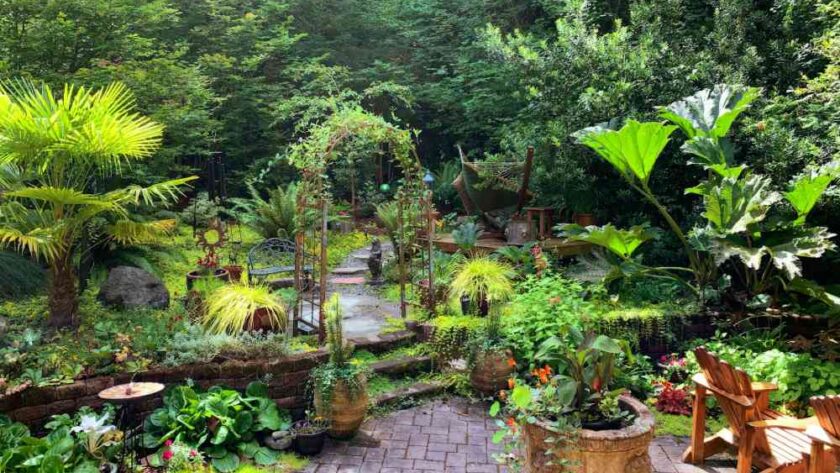The harmonious interplay of form and function within sustainable landscape design can drastically elevate any residential garden’s aesthetic and ecological integrity.
This methodology underpins a philosophy where outdoor spaces are crafted with respect for the natural environment, fostering a synergy between human needs and the flourishing of local ecosystems.
Practitioners of sustainable landscape design employ strategies to conserve resources, such as water and energy, while supporting the local flora and fauna. This approach curtails gardeners’ carbon footprint and instills a serene environmental sanctuary that mitigates the effects of climate change.
Contents
Analyzing the Components of a Sustainable Garden
Digging deeper into sustainable gardens unearths a treasure trove of components instrumental in structuring a verdant ecosystem.
Native plants are prominent in this tableau, their deep-seated roots intimately entwined with the local habitat, furnishing an oasis for indigenous wildlife and averting the spread of invasive species. The mosaic of a sustainable garden further includes:
- Organic practices are vital for soil vitality
- Eschewing artificial agents in favor of natural compost and mulch
- Thus spawning a cradle of nutrient-rich terra firma
In conjunction, water-wise methodologies such as drip irrigation and rain gardens are paramount in resource preservation, ensuring every droplet is utilized precisely.
Design Elements that Enhance Sustainability
The tapestry of design elements interwoven into sustainable gardens is practical and enchanting. In landscaping projects, hardscape design plays a crucial role in creating visually appealing and functional outdoor spaces by incorporating elements such as pathways, patios, and retaining walls.
Permeability in hardscape choices is not just about aesthetics – it’s an eco-conscious decision that allows the Earth to absorb and recharge with rainwater, a simple and effective way to mitigate stormwater runoff.
Xeriscaping encompasses more than drought tolerance; it’s about creating a landscaped space harmoniously with its arid or semi-arid environment, cultivating resilience and synergy with regional climatic conditions. Spaces can become nurturing grounds for biodiversity, transforming them into sanctuaries for bees, butterflies, and birds crucial for pollination and the continuation of local ecosystems.
Sustainable Landscaping Materials and Resources
Suitable materials are at the core of sustainable landscaping, with each choice echoing the environment. Recycled materials, responsibly harvested wood, and locally sourced stones lay down a roadmap of sustainability that does not end at the garden’s edge but ripples outward.
The statement made by these materials is not merely visual – it’s an ecological manifest that advocates minimal environmental disruption. Sourcing materials locally not only reduces carbon emissions but also envelops the garden in the true essence of its surroundings—the embodiment of local beauty.
Integrating green infrastructure into the landscape, such as living roofs or constructed wetlands, merges functionality with natural processes, bolstering sustainability while showcasing innovative design.
The Role of Technology in Sustainable Landscaping
Implementing technology into sustainable landscaping transforms gardens into the pinnacle of efficiency and ecological consideration. Advancements in design software enable the creation of virtual reproductions, where layouts can be extensively trialed and tailored to achieve the ideal balance between beauty and sustainability.
Intelligent irrigation systems surpassed the realms of convenience, evolving into strategic assets that optimize water use, dynamically adjusting to weather patterns and the garden’s specific hydration needs.
The allure of technology continues with solar-powered elements—garden lights and water features that harness clean energy—celebrating the sun’s power in every illuminated path and babbling brook.
Cost Analysis: Investing in a Sustainable Landscape
Changing the lens through which we view garden investments reveals a broader panorama in which initial outlays for sustainable landscaping practices are cast in a new, financially favorable light.
Although sustainable approaches may demand an upfront premium, the dividends it pays in reduced water bills, diminished upkeep expenses, and less reliance on costly lawn and plant care products accrue over time.
Moreover, a sustainably designed garden can become a galaxy of attraction, drawing in prospective homebuyers with its siren call of reduced environmental impact and foresighted design—a tangible and aesthetic investment in the future of our planet.
Getting Started with Your Sustainable Landscape
The genesis of a sustainable garden is often rooted in aspiration and research. Partnering with a professional in landscape design versed in eco-friendly methodologies can be an invaluable collaborator as one navigates the transition to a more sustainable garden. For the eco-ambitious gardener, embarking on this journey may seem daunting.
Yet, the progression towards sustainability can be achieved through incremental, deliberate steps, nurturing a verdant space that reflects personal values and ecological responsibility. Awareness and ongoing education about sustainable practices will ensure the evolution and resilience of your eco-friendly oasis in the face of environmental challenges.
Ultimately, sustainability in the garden is more than a mere collection of plants and eco-friendly materials—it’s a holistic approach that intertwines stewardship of the land with reverence for the natural world.
Its ethos, one of balance and renewal, has the power to craft captivating landscapes and a legacy of which any homeowner can be proud—a nourishing and sustainable gift to the environment for generations to come.




